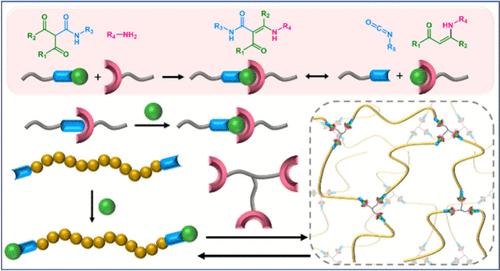Dynamic Enaminoneamide: Enabling Recycling of Isocyanate-Based Polymers with Maintained Mechanical Properties
IF 7
2区 材料科学
Q2 CHEMISTRY, PHYSICAL
引用次数: 0
Abstract
Though possessing advantages of durability and exceptional performances profit from cross-linked structure, it is challenging to recycle and reuse thermoset polymers. Here, reprocessability in industrially relevant polyurethane and polyurea thermosets is unveiled. Unlike prior methods, this strategy does not require the complicated design of monomer structures and is suitable for a variety of polyurethane and polyurea systems. With the enaminoneamide structure inserted, the cross-linked PU possesses reprocessing performance without affecting the mechanical properties. Upon thermal treatment, the enaminoneamide in the polymer network dissociates into isocyanate and enaminone, allowing the materials to be recycled. The reclaimed performance for multiple generations demonstrates long-term reprocessability of the materials. This work offers a convenient approach to make the widely used isocyanate-based cross-linked networks recyclable via involving enaminoneamide structure in the systems without consuming the mechanical properties. Furthermore, for the stability of the product of β-diketone and isocyanate, the sensibility to water is prevented during the synthesis, enhancing the properties of the polymer. Given this strategy is poised for widespread adoption, it may be an important advance in the lifecycle for isocyanate-based thermoset polymers.

动态漆胺酰胺:保持机械性能的异氰酸酯基聚合物的回收利用
热固性聚合物虽然具有交联结构带来的耐用性和优异性能的优点,但其回收利用具有一定的挑战性。在这里,工业相关的聚氨酯和聚脲热固性的再加工性被揭开。与先前的方法不同,该策略不需要复杂的单体结构设计,适用于各种聚氨酯和聚脲体系。在不影响聚氨酯力学性能的前提下,引入了胺酰胺结构的交联聚氨酯具有再加工性能。经过热处理,聚合物网络中的漆胺酰胺解离成异氰酸酯和漆胺酮,从而使材料可回收利用。多代的回收性能证明了材料的长期可再加工性。这项工作提供了一种方便的方法,使广泛使用的基于异氰酸酯的交联网络可回收利用,通过在系统中加入胺酰胺结构而不消耗机械性能。此外,为了保证β-二酮和异氰酸酯产物的稳定性,在合成过程中防止了对水的敏感性,提高了聚合物的性能。鉴于这种策略被广泛采用,它可能是异氰酸酯基热固性聚合物生命周期的重要进步。
本文章由计算机程序翻译,如有差异,请以英文原文为准。
求助全文
约1分钟内获得全文
求助全文
来源期刊

Chemistry of Materials
工程技术-材料科学:综合
CiteScore
14.10
自引率
5.80%
发文量
929
审稿时长
1.5 months
期刊介绍:
The journal Chemistry of Materials focuses on publishing original research at the intersection of materials science and chemistry. The studies published in the journal involve chemistry as a prominent component and explore topics such as the design, synthesis, characterization, processing, understanding, and application of functional or potentially functional materials. The journal covers various areas of interest, including inorganic and organic solid-state chemistry, nanomaterials, biomaterials, thin films and polymers, and composite/hybrid materials. The journal particularly seeks papers that highlight the creation or development of innovative materials with novel optical, electrical, magnetic, catalytic, or mechanical properties. It is essential that manuscripts on these topics have a primary focus on the chemistry of materials and represent a significant advancement compared to prior research. Before external reviews are sought, submitted manuscripts undergo a review process by a minimum of two editors to ensure their appropriateness for the journal and the presence of sufficient evidence of a significant advance that will be of broad interest to the materials chemistry community.
 求助内容:
求助内容: 应助结果提醒方式:
应助结果提醒方式:


